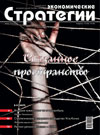Connected Space
Opening address of editor-in-chief.

Opening address of editor-in-chief.
Academician Robert Isganderovich Nigmatulin is one of the most authoritative oceanologists in the world. For 20 years, he headed the largest in the Russian Federation P.P.Shirshov Institute of Oceanology RAS, and now is his supervisor. Winner of the State Prize and a number of other prestigious awards, he does not consider himself a desk scientist, although many scientific problems have to be solved in laboratories. However, for an oceanogist, the most important thing is the expedition, the study of oceans and seas, which cause all climatic changes, and therefore influence conditions of life on the planet. Academician R.I. Nigmatulina has got a strategic mindset. He knows how to bring Russian science to a decent level, how to solve the problem of underfunding, and is persistent in achieving the main goal – to reach those who, having taken the government decisions, are capable to change the situation for the better. Then his beloved country, which he did not leave, although there were a lot of opportunities, would become truly rich, successful and prosperous.
The study is devoted to comparing the characteristics of the macroeconomic dynamics of the US, Germany, China and Russia, with the goal of establishing not only differences and similar elements of this dynamics, but also identifying the most expedient ways to further implement the instruments of the macroeconomic policy pursued. Counteraction to the economic crisis presupposes institutional corrections, since the standard recipes of macroeconomic policy are weak in changing the situation, since the importance of, for example, financial institutions, the banking system, etc. However, the coherence of macroaggregates needs to be taken into account, moreover, it has its own peculiarities in each country, thus, the general methods of macroeconomic policy require detailed elaboration based on the development task and the current dynamics. The expediency of a moderately expansionary monetary policy for the Russian economy is shown, and the comparative and comparative method of analysis confirms that the USA and Russia demonstrate a similar dynamics of macroaggregates in general properties, Germany and China are also close to each other, although some parameters and connections are different. However, in the US and Russia (Fisher’s growth model), the decline in inflation has little effect on growth, in Germany and China, growth is accompanied by inflation (Schumpeter’s growth). The result of the comparative analysis using the matrix of pair correlations and obtained regressions should be used to correct macroeconomic policy measures in the countries examined. In addition, this comparison will prevent governments from mechanically copying macroeconomic instruments.
The article defines the essence of industrial police in the context of the main challenge — objective necessity of modernization of the Russian economy; special attention is given to three debatable aspects of elaboration of the new strategy of industrial police: defining its strategic goal, choice of strategic model of industrial development, defining the main directions of industrial policy. The key importance of the main statements of the Presidential Message to the Federal Assembly for handling these problems is underlined.
The article dwells on actual problems — increase in the volatility of the ruble exchange rate and its depreciation in 2018. At the same time, it is assumed that dynamics of the ruble exchange rate in general reflects the underlying economic processes (including abroad). Before the economic crisis that began in 2008, the ruble exchange rate for many years was mainly strengthening, and its volatility was relatively low. The situation has changed because the economies of a number of countries (in particular, Russia) have entered into a long, difficult period. So, for about a decade, the Russian economy has been showing slow growth. At the same time, the ruble exchange rate tends to depreciate. This allows the authors to assume that dynamics of the ruble exchange rate, which passed from a long upward to a downward stage about ten years ago, may be associated with a similar transition of the economy of Russia and some other countries to a downward stage (in N.D. Kondratieff terminology). The article analyzes a number of approaches to the problems of “long waves” in the economy and a conclusion is drawn up on the necessity to develop the RF monetary strategy (taking into account long-term macroeconomic processes).
According to a number of leading Russian experts in the field of strategy designing and forecasting, in Ust-Kachka they managed to organize the work of the “factory of the new generation thought”. Combination of conceptual, strategic and event levels when considering, not only the predictive assembly by the PEST directions, but also joining into the matrix by the levels “World” – “Country” – “Region” allowed to provide a very high percentage of coincidences between forecast and the fact. Economic Strategies magazine considers it necessary to get acquainted its readers with the results of Ust-Kachka – 2018.
Calculation data of the multifactorial “Strategic Matrix” model methodology showed stability of the relatively low value of Russia’s integral index. However, just such static character of the calculated indicator means an increase of problems in the Russian society, which is evidently shown by hard decline in social support for the authorities activities. Another reelection of V.V. Putin as the President of Russia did not result in prospects for a way out of the crisis in the minds of Russian citizens.
Continuation of instructive stories by V.P. Chichkanov about extraordinary people whom he happened to meet — B.N. Yeltsin, N.P. Koshman, Toshiki Kaifu and V.L. Quint.
The article formulates the law of preserving the general goal as an analogue of the physical laws of conservation, which is applied in designing complex systems with self-awareness, surpassing the researcher in perfection. Seven consequences from this law are presented, they are used for combat planning and control in the conditions of post-industrial war. The principle of action and the role of psychogenic plague as a binary genetic and epigenetic weapon in managing evolution for military purposes are described.
Continuation of the chronicle of events related to the Munich conspiracy of 1938.